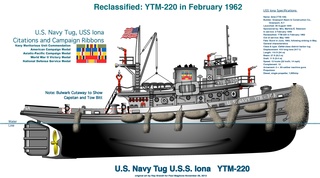
USS Pocahontas (YT/YTB/YTM-266), was a type V2-ME-A1 harbor tug that entered service in the United States Navy in 1943, and was sold in 1976. She was the third ship to bear the name Pocahontas.

Hoga (YT-146/YTB-146/YTM-146) is a United States Navy Woban-class district harbor tug named after the Sioux Indian word for "fish." After World War II, the tug was known as Port of Oakland and then City of Oakland when she was a fireboat in Oakland, California.

USS Awatobi (YTB-264) was a harbor tugboat acquired by the United States Navy during the close of World War II. She was outfitted with two .50-caliber machine guns and assigned to the San Francisco Bay area where she provided tug services, and other harbor services as required.

USS Wenonah (YT-148/YTB-148/YTM-148) was a Woban-class district harbor tug which served during World War II in California ports, and continued her service until she was struck by the Navy in 1974. On 17 August 2009, the Wenonah sank while berthed at Treasure Island, CA, and was raised by the floating crane Left Coast Lifter on 28 August 2009.

USS Acoma (YTB-701/YTM-701) was a Hisada-class district harbor tug built during the end of World War II. She was placed into reserve until 1962, when she was released to the 1st Naval District, where she served as a tugboat for the next 40 years before being disposed of, as excess to Navy needs.

USS Kittaton was a Sassaba-class district harbor tug that served the U.S. Navy at the end of World War II. She served in the Pacific Ocean, often in the Japan and Philippine Islands area and was eventually struck from the Navy list at an unspecified date.
USS Tensaw (YT-418/YTB-418/YTM-418) was a Sassaba-class district harbor tug that served the United States Navy at the end of World War II. She remained in the Pacific Ocean to support the U.S. Pacific Fleet during the Korean War, and continued to serve until she was struck in 1967.

The third USS Osceola (YT-129), previously USS YT-129, later YTB-129, later YTM-129, was a United States Navy harbor tug commissioned in 1938 and sold for scrapping in 1973.
USS Wampatuck (YT-337) later YTB-337 was United States Navy harbor tug in commission from 1942 to 1946.
USS Waneta (YT-384), later YTB-384, later YTM-384, was a United States Navy harbor tug in commission from 1944 to 1946 and from 1953 to 1974.

USS Hiawatha (YT-265), later YTB-265, later YTM-265, was a type V2-ME-A1 harbor tug that entered service in the United States Navy in 1942, and was sold in 1987. She was the third ship to bear the name Hiawatha.

USS Menoquet (YTM-256) was laid down as YT‑256 by Anderson and Cristofani, San Francisco, California 11 September 1943; named Menoquet 5 January 1944; launched 5 February 1944, sponsored by Mrs. Alfred Cristofani; reclassified YTB‑256 on 15 May 1944; and completed and placed in service at Mare Island, California., 7 June 1944. Harbor tugs (YT) were named after American Indian tribes.

USS Oneyana (YTB-262) was a U.S. Navy tugboat laid down as YT–262, 20 June 1943 at J.M. Martinac Shipbuilding Corp., Tacoma, Washington launched 27 March 1944; reclassified YTB 262, 15 May 1944: and placed in service 23 August 1944.

Iona (YT/YTB/YTM-220), a wooden tugboat originally classified YT-220, was launched by Greenport Basin and Construction Company, Greenport, New York, 26 August 1944; sponsored by Mrs. Martina E. Swanson; and placed in service 2 February 1945. She was the second United States Navy ship of that name.
USS Wingina (YTB-395) is a tugboat that was laid down as District Harbor Tug YT-395. She was re-classified while still under construction as District Harbor Tug, Large YTB-395. After her commissioning, she served in the United States Navy from 1944 to 1980.
USS Sassacus (YT-193) was a tugboat built for the U.S. Navy during World War II.

The Natick class is a class of harbor tugboats that have been active since the 1960s. Members of the class are named for Native American peoples and their members, USS Redwing excepted. As of 1 April 2015, five to eight Natick-class tugs remain in active service. Members of this class were designed under project SCB 147A.

The Type V ship is a United States Maritime Commission (MARCOM) designation for World War II tugboats. Type V was used in World War II, Korean War, and the Vietnam War. Type V ships were used to move ships and barges. Type V tugboats were made of either steel or wood hulls. There were four types of tugboats ordered for World War II. The largest type V design was the sea worthy 186-foot (57 m) long steel hull, V4-M-A1. The V4-M-A1 design was used by a number of manufacturers; a total of 49 were built. A smaller steel hull tugboat was the 94-foot (29 m) V2-ME-A1; 26 were built. The largest wooden hull was the 148-foot (45 m) V3-S-AH2, of which 14 were built. The smaller wooden hull was the 58-foot (18 m) V2-M-AL1, which 35 were built. Most V2-M-AL1 tugboats were sent to the United Kingdom for the war efforts under the lend-lease act. The Type V tugs served across the globe during World War II including: Pacific War, European theatre, and in the United States. SS Farallon, and other Type V tugs, were used to help built Normandy ports, including Mulberry harbour, on D-Day, 6 June 1944, and made nine round trips to Normandy to deliver Phoenix breakwaters.
The YT-86-class harbor tugboat was a wood-hulled tugboat design ordered by the U.S. Navy during World War I. 15 ships of the type were launched and completed, 12 as harbor tugs and three as ambulance boats. All were launched at the Mare Island Naval Shipyard in Vallejo, California except for one at the Pearl Harbor Naval Shipyard in Hawaii. In 1920, after the Navy's adoption of alpha-numeric hull designations, the ships were classified as yard tugs YT-86 though YT-90 and YT-92 through YT-99 and ambulance boats YH-1, YH-2, and YH-3.











